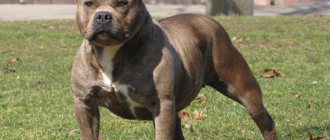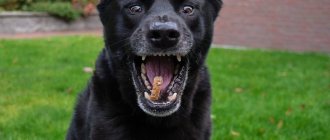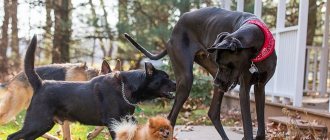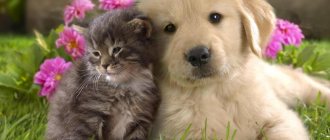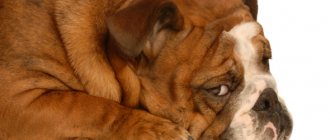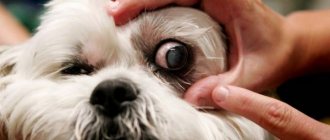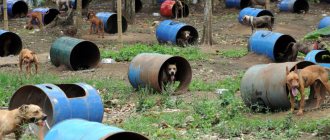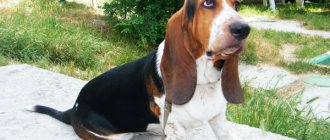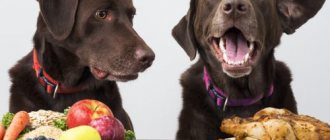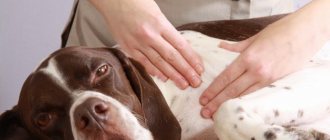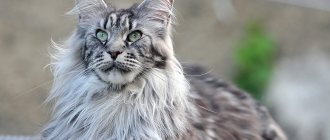At the beginning of the 18th century, dog fighting became popular. Therefore, new breeds appeared, specially bred for such purposes, and old ones that already existed were improved. This is how fighting breeds appeared, although dog handlers do not have such an official term. Most breeds survived even after the ban on dog fighting and became reliable guards and companions. This article contains a list of the most powerful fighting breeds.
American Pit Bull Terrier
The breed was developed in the 16th century in England, where there were many fans of dog fighting. Then, together with the settlers, it came to America, where it was developed and improved for a long time. Pit bull terriers were bought for guarding houses and hunting big game.
This is a powerful dog with well-developed muscles; individuals are often thin. The head is wedge-shaped, scissor bite. Ears are sometimes cropped. Pit bull terriers weigh up to 27 kg. And they are up to 42 cm tall.
Aggression is not genetically inherent in this dog , but it is very easy to train, because breeders for many years believed that the main thing was the ability to fight. But if the owner of the dog raises it as a companion, then he can easily succeed.
The energy they have a lot of makes pitites actively explore nature, play with their owner, and willingly carry out his commands. It depends on the owner of the dog what kind of dog it will grow up to be.
Pit bull terriers have a very vulnerable psyche in childhood , and therefore it is important to prevent psychological trauma, which can later also manifest itself in aggression. Adults are distinguished by mental stability.
The Pit Bull Terrier is easy to train and is capable of performing the most difficult tasks. But to cope with the upbringing and training of a Pit, you need to have a strong character.
In many countries of the world this dog is prohibited for breeding and keeping. Some countries have introduced a special, fairly high tax for owners of this breed.
Extinct dog breeds
Not all extinct dog breeds are known for certain to have existed. Only about 20–25 species have been documented, and all of them became extinct between the 15th and 20th centuries.
Bracque Dupuis
The dog had excellent sense of smell and high search speed.
The Braque Dupuis breed was bred back in 1815 by a famous landowner from the Poitou region (France) and named it by his surname. These dogs were much lighter in build than other French hounds (Bracco is one of the subspecies of this breed) with the same height. The effect was achieved by crossing with greyhounds.
Despite the fact that Dupuis braques, in addition to their versatility, had endurance and speed, they disappeared in the post-war period (1950–1960). This happened for a number of reasons:
- during World War II, the population of almost all breeds declined sharply;
- Dupuy's braques were not too numerous, and due to the presence of dogs similar to them, secondary selection was not carried out, as a result, the original representatives no longer exist, but their blood flows in some French breeds.
Alpine Mastiff
The names "Alpine Mastiff" and "St. Bernard" were used interchangeably in the early 19th century.
The ancestors of the Saint Bernards were once bred in the foothills of the Alps and were called Alpine Mastiffs. Dogs saved people in the mountains and were faithful guards and companions. They had thick, long hair, and in addition, they were massive and very strong. Unfortunately, this wonderful breed was destroyed by an unknown disease in the 19th century.
The Alpine Mastiff, along with the Tibetan Mastiff and Caucasian Shepherd Dog, is one of the earliest dog breeds to reach truly gigantic sizes.
Trochanter dog
Trochanter dogs were common in England and France
The spitting dog is also called a chef's dog or kitchen dog. The purpose of this small animal was quite unusual: it, running in a wheel with a diameter of 1.5 meters, set in motion a skewer with meat.
Dogs were first used for such purposes in the 16th century. John Caius, in his treatise on English dogs, says that they were mongrels. Later, a special trochanteric breed was developed - squat, hardy dogs, reminiscent of modern Jack Russells.
They disappeared in the 19th century, when kitchens stopped using a spit mechanism and the need for such dogs disappeared.
In medieval inns everywhere, small dogs helped turn the spit.
Dogs of the Sakhtu tribe
Sahtu were very loyal dogs, so the Indians kept them as pets.
The Sahtu Indian tribe lived in what is now Canada. Since it was very cold there and there were not enough skins for everyone, it used dog hair to make clothes. The “suppliers” of raw materials were Sakhtu dogs, which had thick fur with abundant down.
These dogs practically did not bark, were excellent hunters and were probably direct descendants of wolves.
Sahtu dogs disappeared in the 19th century due to a catastrophic decrease in the number of the tribe in which they were bred, and the subsequent lack of demand.
Cordoba fighting dog
Many representatives of this breed died in dog fights
The Cordoba fighting breed was bred specifically for guarding and dog fighting in Argentina, crossing bulldogs, bull terriers, boxers and mastiffs. They were aggressive, strong and fearless animals. In the entire history of their existence, they have not lost a single fight to representatives of other breeds.
These dogs became extinct for a banal reason: at the turn of the 20s and 30s of the 20th century, dog fighting was banned in Argentina. Due to developed aggression towards people, the breed was unable to become a pet.
The blood of the breed flows in the Dogo Argentino, whose creator eliminated the aggressive behavior of their ancestors, but left their endurance, beauty and fearlessness.
Norfolk Spaniel
Norfolk Spaniels are one of the most popular breeds of the 19th century in England.
In the past, the Norfolk Spaniel was considered the most numerous breed in England, according to the 1861 book Domestic and Sporting Dogs. These were universal gun dogs, hardy and good-natured.
But the prevalence of the Norfolk Spaniel has led to the fact that the dog has ceased to be valued. In 1902, the breed merged with the Springer Spaniels and ceased to officially exist.
Moscow diver
Moscow divers did not prove themselves as service dogs
The breeding of Moscow divers (and along with them black terriers and Moscow watchdogs) was due to the fact that after the Great Patriotic War there were catastrophically few service dogs left. The military and police needed strong, large animals with high security qualities and thick hair to work in any conditions. For breeding, dogs exported from Germany and the remaining domestic dogs were used.
The ancestors of Moscow divers were German and Caucasian shepherd dogs, as well as Newfoundland dogs. The new breed was very similar in appearance to the latter, but at the same time had a more evil character.
As it turned out later, Moscow divers turned out to be useless: they could not be rescuers on the water, since they attacked drowning people, and in guard duty they showed themselves worse than black terriers. Because of this, they stopped breeding them, and by the 90s the breed had completely degenerated.
Kuri
Kuri played a large role in the traditions and life of the Maori
The Kuri is a New Zealand breed descended from another Polynesian dog, the Poi. These were small dogs of light or black color with an elongated body. Their bark resembled the yelping of a fox. They were used as sacrificial animals, hunters and pets. Kuri were often eaten by the indigenous peoples of New Zealand, and their skins and bones were used to make clothing, jewelry, and gear.
Kuri disappeared at the beginning of the 19th century after Europeans came to New Zealand. Domestic dogs were taken to Europe, where they gradually merged with local breeds, and the remaining ones were exterminated due to their bad temperament.
Talbot
Talbots had an extremely developed sense of smell
The Talbot is a hunting dog, often snow-white in color, that was very popular in the Middle Ages. Her images can be found on the coats of arms of many noble families. Some historians believe that William I the Conqueror brought this breed to England in 1066.
Talbots were placed on the coats of arms of noble families
The Talbots became extinct around the 16th century, but their blood flows in the veins of their direct descendants - the Beagles.
Poi
Polynesians kept poi as pets; children played with dogs with pleasure
The Poi is a Hawaiian dog that is descended from Polynesian native dogs introduced by the Aborigines. They were rather clumsy, but good-natured companion dogs.
They were also used as a source of delicious meat. The natives fed their dogs porridge made from the roots of the taro plant; this diet made the animals fat and inactive, and their meat was believed to become even tastier.
The Poi disappeared as a result of gradual mixing with other breeds in the middle of the 20th century. In the 90s, one of the zoos tried to restore the breed, but the efforts did not bring results.
Bulenbeitzer (bullman)
The dog of the Bulenbeitzer breed belonged to Peter I
The Bulenbeitzer is a very ancient breed of baiting dog. They were descendants of Assyrian war dogs, which were brought to the territory of the Gauls and Saxons by the Phoenicians. Bulenbeitzers took root in these nations due to the constant need to hunt forest bison. The Bulldog was a hardy, strong dog with short hair and an elongated muzzle.
At the turn of the 17th-18th centuries, the popularity of the breed began to decline. The reason was the reduction in the number of bison and, as a consequence, the disappearance of the need for these dogs. But even before that, bulldogs became the progenitors of modern boxers.
Paisley Terrier
Paisley Terriers became the ancestors of Yorkies
Paisley is one of the ancestors of the Yorkshire Terrier. In the 19th century, English ladies used this breed as decorative dogs. Paisley Terriers had long, silky hair, small size, and an easy-going, people-oriented character.
These dogs disappeared at the end of the 19th and beginning of the 20th centuries due to high competition at exhibitions with Skye terriers.
The fact is that the handsome Paisley Terriers were exhibited as a variety of Skyes and took all the prizes from them. Then the English Kennel Club refused to encourage such dogs, and interest in them practically disappeared.
Coton de Reunion
The Coton de Tulears became the descendants of the Coton de Reunions, who disappeared in the 17th century
There is a beautiful legend about the Coton de Reunion: it is believed that they survived a shipwreck, escaped from sharks and eventually sailed to Madagascar. But it is most likely that they were brought to the island by sailors. There, the Coton de Reunion mated with local street dogs and as a result became the ancestors of the Coton de Tulear, which is still living today.
The breed disappeared back in the 17th century, running wild and gradually merging with local pariahs (mongrels).
Old English Bulldog
Newly created Old English Bulldogs are very similar to their predecessors
Old English Bulldogs are a baiting breed bred in England for bull baiting. These dogs are considered the ancestors of modern English bulldogs. They were squat, but large dogs with well-developed muscles and an iron grip in their jaws. The breed was highly valued by aristocrats.
Old English Bulldogs became extinct after bull baiting was banned in the 19th century. But recently, several enthusiasts were able to revive the breed's phenotype. There are now dogs in the world called "re-created Old English Bulldogs."
Techichi
Techichi were considered sacred dogs
Techichi is one of the oldest breeds, whose descendants are considered to be Chihuahuas. These dogs lived with the Aztecs, Toltecs and Mayans since the 15th century BC. e. They were mute, resembled modern Chihuahuas in appearance and size, and had a slightly elongated coat.
Only nobles, rulers and priests were allowed to keep techichi. They were used for sacrifices, burials, as a source of meat and as pets.
The Techichi became extinct as a result of the activities of the Spanish conquerors. They exterminated everything connected with the culture of the Indians, including their dogs.
Alans
The Caucasian Shepherd is one of the descendants of the ancient Alan dogs
Alans lived in the Caucasus mountains back in the 3rd century BC. e. They were bred by the Alans (indigenous people of the Caucasus) to guard livestock and hunt. These were light-colored dogs, large, short-haired, hardy and ferocious.
Alans as such did not become extinct, but disappeared, mixing with other breeds. Their descendants are bulldogs, Caucasian shepherd dogs and mountain greyhounds.
Bull and Terrier
The Bull and Terrier is a cross between the Old English Bulldog and the Old English Terrier.
The Bull and Terrier is a cross between Bulldogs and Terriers that was used for fighting and hunting. These dogs did not have an established type and were not distinguished by their beauty, since selection for external qualities was not carried out during their breeding. Bull and Terriers became the ancestors of Bull Terriers, Pit Bulls and Staffords.
Bull and Terriers were bred by the beginning of the 19th century, and from 1835 their popularity began to decline due to the ban on baiting. By the beginning of the 20th century, they were completely assimilated into the breeds that descended from them.
Medelian dog (medelyan)
The name of this breed comes from the name of the Italian city of Mediolana, now known as Milan.
The Medellian is a dog from the Russian Empire that is descended from the Italian Molosser. These animals were valued for their enormous size, strength and high hunting abilities. Their blood was used to improve many breeds of European Great Danes and Mastiffs, as well as hounds. Medellans were equal in value to purebred horses; as a rule, they were used for hunting bears.
The Medellians became extinct due to a ban on bear baiting in the 1860s. Several individuals survived until the 1917 revolution in the Gatchina hunt, but after that they also disappeared.
Dogs, like any other animal species, evolve over time, and some breeds cease to exist. But their blood flows in the veins of modern pets.
English Mastiff
Scientists believe that the breed originates from Tibetan mastiffs. Already in ancient times, powerful, ferocious dogs were known, who fought in armies along with soldiers and took part in gladiator battles.
The Mastiff is a heavy, but at the same time very impressive dog, with soft light hair, an almost square head, a short square muzzle, and high-set ears.
With appropriate upbringing, these are kind animals that love their owners. They are docile, obedient, never attack or even bark for no reason, realizing that most often their appearance is enough to intimidate.
They love to show their power by stretching out imposingly on the floor in the presence of strangers, sensitively raising their ears and deliberately demonstrating complete indifference to what is happening.
The Mastiff needs education and training. These giants are well aware of the power they have, and it is important for the owner to ensure that this power is directed in the right direction. But mastiffs are easy to train and quickly become good companions, reliable bodyguards and watchmen.
Breeds similar to Dogo Argentino
The Argentine has the greatest external resemblance to the Cordoba fighting dog, a breed that does not exist today. Both Vidas are natives of Argentina.
Cordoba Fighting Dog VS Dogo Argentino
You can also find common features with Great Danes, but it is difficult to confuse these breeds.
Great Dane VS Argentine Mastiff
It is quite difficult to confuse it with other breeds; both colors and external characteristics differ.
Alano Espanyol
They are also called Spanish bulldogs. The Alans were described in literature already in the middle of the 14th century. Goya loved to depict them on his canvases. Most likely, this breed came to the Pyrenees with the Alan tribes who invaded the peninsula in the 4th century.
They took part in corridas and were bred for night hunting on horseback. During the conquest of America, they were used to hunt Indians.
The Alano has short, rather thick fur with different spots. The color is most often fawn. The muzzle is short, with wrinkles, the nose is large. The skin has folds on the neck.
But by nature they are shepherds, a working breed with protective qualities. He knows how to remain calm and at the same time quickly makes decisions in a critical situation.
It has great strength and can easily knock down a bull weighing at least 300 kg. But at the same time she treats children like a gentle nanny . Alano quickly masters the territory belonging to the owner and strictly monitors order on it.
Saint John's Water Dog
These friendly, large dogs originated in Newfoundland. They loved water and were considered excellent swimmers. Thanks to their dense undercoat, they did not freeze in harsh conditions and could swim in the cold sea.
Breeders took them as a basis when creating modern breeds such as Labrador and Golden Retriever. In the 20th century, water dogs disappeared.
Brindis fighting dog
Rare modern breed. She was bred by dog handlers in the Italian city of Brindisi by crossing a Canne Corso, a pit bull and a Rottweiler. The dog is designed for fighting and guarding.
Externally, the Brindisian is very similar to large pit bulls. He has a wide chest, a large head, and docked tail and ears. The coat is short. They reach 56 cm at the withers and weigh up to 50 kg.
Such dogs require strict training , a strong owner and very early socialization. The Brindisian is loyal to his owner, but he is very aggressive towards others and can easily attack other dogs. Not suitable for the role of a companion at all.
Description of the appearance of representatives of the Dogo Argentino breed
The height of Dogo Argentinos at the withers is above average - up to 68 cm. They have a strong, muscular and proportional physique. The muscles stand out in relief under the short hair, so the dog looks massive and strong. But the Dogo Argentino weight is small, on average 40-45 kg. Therefore, they are not devoid of grace and elegance. Some individuals can weigh up to 55 kg, but these dogs are not prone to weight gain.
Head
The head is large, with pronounced muscles and prominent brow ridges. The occipital protuberance and stop are smoothed, there are small depressions in the temple area. The muzzle tapers slightly towards the nose and is the same length as the skull. The jaws are strong, the teeth are large, even, providing a strong bite and a powerful grip. The bite can be straight or scissor.
The cheeks are muscular, without folds, and fit tightly. Lips are thick and should be well pigmented. The edges are free, but do not droop. The nose is slightly turned up, so the top line is concave. The Dogo Argentino's nose is large and black. The eyes are brown, set deep and far apart. The eyelids are close fitting and black pigmentation is desirable.
In their homeland, it is customary to crop the ears of Dogo Argentinos. They are made triangular and small. They are widely spaced and set high. When docked, they give the muzzle a more ferocious expression. Puppy ears should be cropped before 3 months of age.
Now in many countries it is prohibited to dock animals. Natural ears are set wide apart, hanging down, covering the back of the cheeks. They are thick, with rounded tips. Many owners don’t want to crop their pet’s ears because it makes them look more friendly.
Torso
The neck is thick and muscular. The scruff is well defined, there are small folds on the throat, there is no dewlap. Rectangular body. The chest is voluminous, goes down to the elbows, the stomach is slightly tucked. The back is muscular and wide, the lower back is slightly raised.
The tail continues the top line. It is quite long, thick, saber-shaped. When moving, the dog lifts it, but does not throw it over its back.
The photographs show the body features of these dogs:
Limbs
The limbs are muscular, with strong bones. The front ones are level and widely spaced. Elbows are pressed and directed back. The hind legs are set at an angle, providing a good push. This is another characteristic feature of the breed.
The thighs are long and the joints are well defined. The paws are round, thick toes are gathered into a ball, the pads are hard and dense. The dog moves with a confident, sweeping step. This is usually a trot or canter. An uncharacteristic gait is considered a disqualifying defect.
Coat and color
The skin is thick, elastic, light. It glides freely, but does not form folds. The coat is short, no more than 2 cm. It feels soft and smooth to the touch. It usually has no undercoat, but if the dog lives in a cold climate, it may have undercoat. Shedding is seasonal and very abundant.
The color of the Dogo Argentino is not very diverse. According to the standard, the color must be white; a slightly creamy or milky tint is allowed. Possibly a black spot on the face around the eye or ear. It should not exceed 10% of the surface of the head.
Disqualifying faults
The standard clearly defines what a dog's appearance should be. Any deviation can become an obstacle to breeding and participation in exhibitions. The most common disadvantages are:
- weak muscles;
- insufficient pigmentation of the nose;
- saggy lips;
- light eyes;
- pigmented skin;
- flat ribs;
- height less than 60 or more than 68 cm at the withers;
- ambling;
- any color options except white;
- dark spots on the body.
Photos complement the description of the dogs’ appearance:
Dogue de Bordeaux
The breed was bred in France a long time ago, but gained popularity only towards the end of the 19th century.
The Dogue de Bordeaux can weigh up to 90 kg. Squat, with folds on the body, with reddish smooth fur. A powerful head rests on a short neck.
Many people avoid them because of her appearance, inherited from her military background. But the owners of Dogues de Bordeaux speak of them as soft, friendly animals, at the same time aware of their power.
Bordeaux will not take part in dog quarrels , will not descend to barking for no reason, they are full of dignity and know their worth. But they zealously protect their master and their territory. They have lightning-fast reactions.
If a dog is properly raised, it calmly accepts other pets and does not demonstrate love for its owner by jumping and drooling. But if anger is encouraged, then it is capable of attacking other dogs for no reason and showing aggression towards strangers: growling, baring its teeth.
The Dogue de Bordeaux is vulnerable and touchy ; he cannot be raised by shouting or raising his hand. He does not tolerate undeserved punishments and incomprehensible commands. The Great Dane needs great physical activity and constant attention from the owner, in which he must feel like the leader of the pack.
How to buy a Dogo Argentino puppy
The Dogo Argentino is popular in our country. Therefore, buying a purebred puppy is not a problem. It is better to contact a nursery or a reputable breeder. You can find them at exhibitions or from reviews on the Internet. This is a guarantee that the dogs are healthy, have not been used for fighting and have all the documents. In Moscow, such a puppy can be bought for 30-50 thousand rubles. Show class dogs cost more – from 70 thousand.
Puppy for sale at 1.5-2 months. When purchasing, you need to get acquainted with the documents for the animals, there must be all veterinary certificates and vaccinations required by age. You need to get to know your mother, she shouldn't be too aggressive. Study the conditions of keeping animals, the behavior of puppies. It is recommended to choose an active, cheerful baby. The following signs will indicate that he is healthy:
- smooth, shiny coat;
- no unpleasant odor;
- clean eyes and ears;
- not bloated, soft belly;
- confident gait.
The photo shows what Dogo Argentino puppies look like:
Photos will complement the description of these dogs:
Dogo Argentinos are not a dog for everyone. Only those who are ready for difficulties and communication with a dominant, stubborn dog should get such a pet. If he is not raised correctly, he can become dangerous to others. But those owners who show love, patience, and pay a lot of attention to their pet receive a devoted friend and reliable protector.
Bull Terrier
The Bull Terrier was bred in the mid-19th century in England. There are many legends surrounding this breed related to aggressiveness. But they arose primarily because of the appearance of this dog.
The head has a long oval shape, between the ears the skull is completely flat, the eyes are small, and triangular, very close-set ears stick out. The limbs are strong and muscular. The wool is smooth, hard, and can be either pure white or colored.
Bull Terriers were actually bred as a fighting breed. And for this she received everything: steel jaws, a body that seemed to consist only of muscles. But the Bull Terrier can be a good protector and guard if properly trained.
Description
The Cordoba Fighting Dog was lean and muscular with a short coat that was known to be white with sparse small brown markings. They were known as a cross breed of Mastiff and Boxer and Great Dane. Typically, they had their ears cropped to ensure that they were not torn off in a fight, and this quality made them an ideal hunting dog, and for fighting other dogs. They were mainly kept in cages only for safety reasons due to their aggressive behavior. Although the most valuable specimens were pure white, many were red, tan and yellow. It was known there that there were different colored types of these breeds. These dogs are known for their lack of aromatization ability and they only excel in fighting. They are believed to have descended from ancient Molossus dogs.
Bulldog
The breed originated in England and was once a pickling dog. In the process of its development, it went from fighting to decorative. The name translates as “bull’s head”, they were used in fights with bulls.
The bulldog's muzzle is covered with skin folds, they have a depressed nose, and a small head. The body is squat. Refers to the size of medium dogs.
Modern bulldogs love comfort, prefer to stay at home, and can sleep all day. But they also love to walk. They willingly play with children and can chew anything. This dog is a pet and companion.
Paisley Terrier
These terriers are the ancestors of the currently popular Yorkies. In the 19th century, English aristocrats loved such decorative pets. The dogs were short, with short legs, had an elongated body, covered with long, silky hair that spread along the ground.
Their character was flexible and sociable. They were brought out for exhibitions. But the demand for the breed ended, so it gradually died out completely.
Gul-dong (Pakistan Mastiff)
The breed was bred in Pakistan during the British colonization. They were used in hunting to bait large animals and as a fighting dog. Fights between the gul-dong and the bear were often held. They are still used for dog fighting in Pakistan today.
In appearance they resemble a bull terrier. The traditional color is white with dark spots.
They are kept for hunting and as guards. Gul-dongs help herd cattle. Not suitable for keeping in an apartment or house. Rarely distributed in Europe.
story
The Cordoba fighting dog originated in Cordoba, Argentina. He has been noted for his willingness to fight to the death and his high pain tolerance. Additionally, many members of this breed died in pit dog fighting, contributing to the extinction of the breed.
Cordova was capable of hunting in a small pack of males and females; otherwise it will probably turn on his pack mate.
The Dogo Argentino is derived directly from this breed. In the 1920s, breeders developed the Dogo Argentino, crossing the Cordoba fighting dog with other breeds such as the Dogo, Great Pyrenees, bulldog, bull terrier and Bordeaux.
This dog breed originated from Argentina; these dogs were used primarily as military dogs. These dogs were fierce and aggressive, and they were used as cattle dogs. Dogs were used as a form of entertainment for their masters through dog fighting. They are believed to have been developed by crossing Spanish fighting mastiffs such as the Cane Corso, Doga, and Perrault. Pressa de Canario, Dogo Argentino and bulldogs with imported English bull terriers.
Presso de Canarrio
The Dogo Canario was used for hunting and slaughtering livestock. The purpose of the breed is hidden in its name: “presso” translates as “to press.” The dog had to pin the large animal to the ground and not allow it to move until the owner arrived. They were quite aggressive, and a decree was issued on the island allowing only butchers to keep such dogs.
The dogs reach 64 cm at the withers, have short hair, and powerful, widely set limbs.
Presso is difficult to train and educate; he must understand who the leader of the pack is and obey unquestioningly. Canario himself never tries to find a reason for a fight, but he doesn’t shy away from it either. Can be aggressive towards other animals. But he is a very reliable watchman and protector.
What you need to know about education and training
The animal is capable of remembering a wide variety of commands.
Like any dominant animal, Great Danes need early socialization. For parenting to be successful, you need to show patience and endurance. If the owner trains the dog on his own, he must immediately take the position of leader. “Argentines” love motivation with a tasty treat. They cannot be punished by force for disobedience - they will immediately harbor a grudge.
The rules for caring for such a breed will be quite simple, but they should be strictly followed.
The coat is brushed twice a week. It is especially convenient to use a special glove with a rubber palm. During shedding, the coat is tidied up every day. The pet will not only be beautiful, but also immensely satisfied after such a massage. Especially for clean people, caring for an “Argentine” will be very stressful. The dog sheds heavily, covering furniture, carpets and clothes with fur. It is not worth torturing your animal with frequent bathing. Water procedures are repeated only once a month.
The ears are regularly wiped with a damp cotton pad to remove dirt and oil. Eyes are washed with chamomile tea. The claws are shortened with a nail clipper for large animals. Teeth are brushed twice a week with a special paste. Argentines don’t mind eating tasty and hearty meals, but they can quickly gain weight. Feeding should be strictly dosed. The pitiful look of the dog’s innocent eyes should not break the iron will of the owner.
The diet is formed either from natural food or from feed, which cannot be mixed.
The dog should not be given the following foods: fatty meat, grapes and nuts, river fish, smoked meats, legumes.
Health and illness
The health of such strong dogs is quite good. The most common illness for them is deafness. Allergies are possible, which is why “Argentines” are not given chicken, as well as joint dysplasia.
How to choose a Dogo Argentino puppy
The puppy is separated from its mother no earlier than 1.5 months. It had to grow in a well-equipped place, without drafts, dampness and scorching sun. A puppy that eats well, is active, and doesn't hide from people is a worthy candidate for a pet. You should not lose sight of the appearance - beautiful coat, moist nose, clean ears and eyes.
Mallorca Bulldog
This breed is also called Ca de Bou. They were bred as fighting dogs for bullfighting and dog fighting. Therefore, they have powerful jaws, a square head, and strong limbs. The skeleton is strong and can withstand heavy loads. The color is usually fawn.
Absolute obedience to man was always required from Ca de Bou, which was important in bullfights. They are devoted bodyguards and excellent watchmen. In the absence of the owners, it is impossible to enter the territory protected by the bulldog. But they pursue the enemy only to the borders they protect.
When the owners are at home, they are obedient, peace-loving animals. They love their owners very much, but they do not impose themselves, but wait for attention to be paid to them. They have a strong psyche, adequate behavior, never bark over trifles, and adapt well. Easy to train, smart, capable.
Varieties of colors
According to the standard, the color must be completely white; a black or dark spot on the skull, or on the ear, or around the eye is considered acceptable.
Tosa Inu
It was bred for dog fighting in the Japanese principality of Tosa. For many centuries they were trained to fight without blood, according to the principle of sumo fighters, without biting or grabbing the enemy, but by pressing him tightly to the floor.
The most common colors are red and black. Broad chest with strong ribs. Very thin skin.
Tosas are wonderful companions , very active, love when their owner takes care of them, and can easily learn anything. They enjoy training. Fearless, solid in character. They love to explore large spaces; it is better to keep them in a private country house.
Tosa Inu needs to be trained from an early age. They are distinguished by good health and longevity.
Coton de Runea
Charming small dogs with white fur. They were brought to Madagascar by sailors who kept them as faithful companions. According to another version, they were shipwrecked and managed to swim to land. There, representatives of the breed crossed with stray dogs.
As a result, we got very cute fluffies with cute little faces. In the 17th century, the dogs finally went wild and gradually merged with the local mongrels.
Brazilian Fila
Fila translated from Old Spanish means “to grab, cling to, hold . National dog of Brazil. She got there along with the Spanish conquistadors. Phila had many responsibilities: they guarded the settlements of the colonists, accompanied the carts, guarded slaves, herded livestock, and participated in hunting large animals.
They are very hardy, protect herds well, and even large animals listen to them.
They understand the owner at a glance and a special trusting relationship develops between a person and such a dog. They get along well with children. An excellent watchman and bodyguard. They treat strangers with distrust and will not leave the owner in their presence.
Mentions of the breed
The film Dogo Argentino, released in 2004, is a co-production between Argentina and Spain. The film about how the Dogo Argentino Bonbon helps the unemployed Juan get rich was a success in both Americas and Western Europe. The film has participated in many international film festivals.
Famous representatives of Argentines
I would like to tell one heroic story of a Dogo Argentino named Morocho. In 2008, in an Argentine village, two girls Yoli and Sophie went to collect figs. While getting ready, Yoli saw a puma on a tree, basking in the sun. The girls tried to quickly climb down from the tree and run away, but the puma had already scented its prey and began pursuing.
That day, their pet, a dog named Morocho, went for a walk with the children. The dog, without hesitation, rushed to the defense of his little friends, entering into a fight with the predator. Thus, Yoli and Sophie managed to escape.
The father heard the children's cries for help and rushed to find out what was wrong. Seeing his frightened daughters and asking what happened, he ran to the scene of the fight. Upon arrival, he found a wounded Morocho and a dead puma; the dog won the fight, but was badly injured. The dog recovered after 10 days and became a local hero.
Morocho Photos
Character and habits
The Dogo Argentino, despite its appearance, is a wonderful companion that can protect its owner and his property.
Character Traits of Boys and Girls
- ♂︎ Boys are distinguished by stubbornness, temperament and a tendency to dominate. At the same time, he is always ready for classes and training.
- ♀︎ Girls are more obedient, flexible, and better suited for living in a family with children. But hormonal changes cause severe mood swings.
Friendliness
The Dogo Argentino has warm feelings for all family members, but chooses only one owner . This breed needs frequent physical contact with loved ones, so the huge dog often tries to fit on the owner’s lap, puts its head up for scratching, and lies down on its legs. All household members are required to pay attention to the pet, but at the same time, respect his personal space.
Strangers whom the Great Dane sees for the first time do not cause aggression in him, but there is no point in talking about friendliness. The wariness will go away after a few meetings, and the Dogo Argentino will expose its head to the caresses of a good friend.
You should not have other pets. Hunting traits still remain in this breed. The Dogo Argentino may mistake a cat or bird for legal prey.
Submission will be required from other dogs. The “Argentine” always claims a dominant position, and his large dimensions and powerful jaws are a powerful argument.
Animals encountered on a walk can also awaken the hunter's instinct. To avoid trouble, you will have to walk your Dogo Argentino in public places only on a leash.
Attitude towards children
A large pet is not averse to playing and having fun in the company of children . But the size in this case is a disadvantage. An accidental impact and the child may fall and be seriously injured. In addition, you will have to train not only the dog, but also the children. The Great Dane will not tolerate intrusiveness and rudeness. The child will have to be taught to respect the animal's personal space. You should not leave your Dogo Argentino alone with children.
If you think that Dogo Argentinos are extremely serious and that affection and friendliness are alien to them, then you are mistaken. Argentines, like many dogs, love to hug and kiss their owners, direct evidence in the pictures.
Security qualities
The Dogo Argentino has all the qualities necessary for a guard : strength, speed, powerful jaws, devotion to the owner and the desire to protect him.
The Great Dane will warn a person who has invaded the territory with a roar and demonstrate itself. The dog has a high level of intelligence and is quite capable of independently deciding what is dangerous and what is not and how to behave in the appropriate situation. You should not provoke the dog; if the Argentinean, having assessed the situation, considers you dangerous, he may attack.
The “Argentine” stands up without hesitation to defend the family in which he lives . The owner should not be in any danger. Reliable protection from both people and animals.
Interesting Facts
Although the Dogo Argentino breed has existed for only a short time, there are a lot of interesting things associated with it:
- The prototype of modern Argentines was a hybrid of two lines - Arhuacana and Guarani. The first branch was formed from crossing the dogs of Cordoba with the Dogue de Bordeaux, the second - from mating with the Irish Wolfhound. Not a single one of them has survived to this day in its pure form.
- The Dogo Argentino is the only officially recognized breed that originated in Argentina.
- In Ireland, New Zealand, Australia and Great Britain, these dogs are considered one of the most dangerous, and their breeding is prohibited by law.
- In the 70s of the last century in the United States, Argentines were used to serve in the police. But the dogs behaved too harshly when detaining the intruders and quickly abandoned this idea.
Advantages and disadvantages
The dogs are in good and healthy health, but some dogs experience hip dysplasia, limping, and even congenital deafness. You can go out for a quiet walk with your Great Danes, or take them with you for jogging or cycling.
They are good trackers and careful hunters. They should not be kept together with other breeds of dogs and animals , as they are often aggressive. They are friendly, responsive and kind to people.
Tell us about your experience of purchasing and keeping a Dogo Argentino. We look forward to your answers and comments.
Differences between wolves and dogs
The gray wolf is a wild animal, and the dog is its domesticated form. A study of the DNA of these animals fully confirms that the dog and the wolf have a common ancestry. Dogs evolved from wolves and are the first animals that we humans domesticated. Although dogs and wolves are full-fledged relatives, these animals have completely different physical characteristics. Distinctive appearance features of a wild gray wolf and a dog:
- wolves have a slightly larger skull;
- the wolf has a physically larger brain, as well as larger teeth, compared to dogs;
- dogs have smaller and wider skulls with a shorter muzzle;
- a wolf's paw is twice the size of a dog's paw;
- the tail of a wolf and a dog has a different bend;
- Dog teeth have a less complex pattern of sharp ridges.
The dog has lost some of its hunting abilities due to domestication. But dogs can often read their owners' facial expressions. The wolf is a natural hunter. Wolf teeth are designed for hunting. Wolves have stronger molars than dogs, which allows them to break large bones. It was the different habitats that made these animals so different, despite their unconditional kinship.
Tips for choosing a puppy
Purchasing from a kennel guarantees you a puppy that will be a true Dogo Argentino in appearance and character. The pedigree of the parents of the RKF-FCI sample, a test for dysplasia, a veterinary passport, a puppy card and a brand - this is a set of a purebred puppy that will grow into a dog from the exhibition photographs.
A good breeder will not sell you a puppy under two months old, but he will be happy to give advice on the characteristics of the breed and tell you about his dogs. The area where Dogo Argentino puppies are kept should be tidy and their mother should not look emaciated.
You should not choose a cowardly and downtrodden puppy. Better pay attention to a cheerful, playful, moderately well-fed baby with a good appetite. The fur is white, the skin is without red spots, the nose is wet and shiny, and the ears are clean and without an unpleasant odor.
Puppies come in show, breed and pet class. If you are not going to participate in exhibitions, a pet-class dog is suitable for you. Usually this is a puppy with disqualifying defects in appearance or simply a dog that meets the breed standard, but the breeder sees that the puppy cannot get a higher rating than “very good” at the show.
Show-class Dogo Argentino puppies are the future owners of exhibition cups, diplomas and rosettes. At the same time, a show dog will not always be a great producer. Breed class are pedigree dogs that can participate in breeding. They can often produce high-quality offspring when mixed with the right bloodlines and successfully mated.
But if you buy a two-month-old puppy, the breeder can only guess what this dog will be like, and everything can change. A puppy of breeding class, who is nothing special, can grow into a champion, but a puppy, on whom great hopes were placed, will develop some significant flaw.
Pros and cons of the breed
The Dogo Argentino has both good and bad sides:
| Advantages | Flaws |
| Friendly disposition | Need for socialization |
| Devotion | Hunting for small animals |
| Good learning ability | High price |
| Developed hunting instinct | Tendency to dominate |
| Suitability for residential use | Need for long walks |
| Low maintenance |
Uneven fight
On the appointed day, many people gathered. The spectators surrounded the cage with the wolf in a dense crowd. No other animal has ever received such audience attention. Excitement grew and people began to make bets. Without exception, everyone bet on the powerful, battle-hardened dog, kept on a short leash by its owner.
In comparison with this gladiator, the wolf looked like a pitiful wolf cub, and no one had any doubt that this creature would certainly die in the first minute of the battle.
The wolf, despite the growing excitement of the crowd, continued to huddle to the floor in the corner of the enclosure, not understanding how he could attract the attention of these people, and only a subtle observer could notice the wild fire rarely flashing in his eyes.
Suddenly, the iron bolt clicked loudly, causing the wolf to flinch and turn around towards the sound.
Another animal appeared in the open door - a powerful and merciless wolfhound, who without hesitation attacked the wolf.
Everything started spinning, spinning in a whirlwind, and for some time, no one could understand who grabbed whom and by what. Everyone was waiting for the fight to end soon, which, for some unknown reason, did not come, as the fight between the two animals continued.
